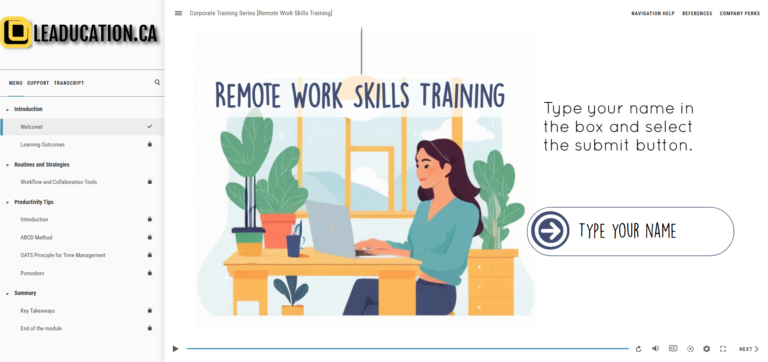Seamless Onboarding for New Hires
[Remote Work Skills Training]
Audience: New hires, internal transfer
Pain Points: Time management, communication tools, and maintaining a work-life balance.
Learning Environment: Self-paced, interactive Articulate Storyline 360 course.
My Responsibilities: instructional design (action mapping, storyboarding, prototype, full build), visual design, eLearning development
Resources & Tools Used: Articulate Storyline 360, Fooocus AI, Adobe Photoshop, Adobe Illustrator
Why does this training work?
Strategy: As part of this project, I structured the course using a scenario-based flow combined with microlearning elements. By weaving wellness reminders, tool tutorials, and workplace simulations into small, focused slides, the course guides remote employees through real-world tasks while reinforcing core values like time management, communication, and wellbeing.
Engagement: To keep learners actively involved, I integrated variables, interactive triggers, gamified choices, and soft-skill micro-moments—such as clicking to turn on the PC, select water for hydration, or choose personalized perks. Each action is designed to be intuitive yet meaningful, helping new hires engage with the material in a way that feels hands-on and relevant to their remote work reality.
Results: Instead of a traditional quiz, learners complete the training by printing personalized completion and perks certificates, offering both a tangible milestone and a sense of accomplishment. This approach reinforces positive reinforcement, encourages self-direction, and reflects the company’s commitment to both performance and wellbeing.
The Idea
This training focuses on helping new hires or internal transfers seamlessly integrate into the company by introducing them to the workflow, organizational culture, and essential communication tools. It also highlights company perks as a vital part of the culture, ensuring a well-rounded and engaging start for new employees. As part of this onboarding design, I aimed to create a seemless experience that not only informs but also inspires confidence and connection from day one.
Analysis (Understanding Learners' Needs)
Key Questions for Needs Analysis
- What are the common struggles of newly hired remote employees?
- Which collaboration tools does the organization use?
- What strategies improve engagement in asynchronous training?
- How can onboarding help new hires feel more connected to the team and mission?
- In what ways can we highlight our dedication to employee wellbeing as a core company value during the onboarding training?
S.M.A.R.T. OBJECTIVES
Employees complete the training by following each step and printing two certificates at the end:
• A completion certificate to recognize their onboarding progress
• A perks card that introduces company benefits in a clear and friendly way
These final touches give employees a sense of accomplishment and help them feel welcomed (no quizzes required).
- Apply time management techniques
- Use collaboration tools
- Develop a positive attitude and support
All objectives are achieved within the onboarding training module, using interactive activities, guided simulations, videos, and reflection prompts.
Employees successfully complete the module by following all training steps and printing two final certificates:
• A completion certificate acknowledging their participation
• A company perks card highlighting wellbeing initiatives and benefits
These artifacts reinforce engagement and provide tangible takeaways without relying on quizzes or full simulations.
Desıgn
My Process
Preparation of Content
I started by gathering credible research and workplace wellness insights to support each slide’s message, from hydration tips to time management methods like OATS and Pomodoro.
Relying on Gamification
I embedded gamified moments across the training, such as selecting archers to reveal objectives, turning on the PC, or interacting with perk choices, to increase engagement without overwhelming the learner.
Offering Relatable Moments
Whether it’s grabbing a bottle of water or choosing your lunch perk, I used everyday scenarios to create emotional connections and help new employees feel seen, supported, and valued.
Collecting the Right Media Assets
I curated visuals, audio, and animations (like GIFs and video clips) to create a cohesive and immersive experience—matching brand tone and boosting retention.
Employing a Strong Visual Identity
Using Adobe Creative Suite and Fooocus AI, I designed modern, calming layouts that reflect remote work settings. Visual consistency ensured clarity while aligning with wellness themes and company culture.
Sharing Interactive Prototypes and Showcasing Personalized Takeaways
I built and tested each screen in Articulate Storyline 360, refining accessibility, flow, and usability before finalizing the course.
Instead of standard quizzes, I wrapped up the training with printable certificates, a completion card, and a personalized perks card, giving learners a tangible sense of achievement and reinforcing company values.

For me, storyboarding is one of the most important steps in the instructional design process. It helps me translate ideas into something visual and organized, connecting the planning phase to actual development. It lets me map out how the content, visuals, audio, and interactions will work together on each screen before I start building anything.
In this storyboard:
-
User Sees / Hears outlines what the learner will experience.
-
Graphic Assets help me track the visuals and media I need.
-
On-Screen Text & User Interaction shows exactly what will appear and how the learner will interact.
-
Additional Notes are where SMEs or other stakeholders of the project can explain design choices or flag special behaviors, like, wording, hidden slides or triggers, etc.
This process keeps everything aligned, reduces guesswork during development, and gives me a clear structure to build from. It also makes collaboration smoother when working with SMEs or other developers in the team.
Development
Accessibility and functionality

I took steps to ensure that the design of this e-learning module followed digital accessibility best practices, aligned with AODA and WCAG standards. This included checking color contrast across all slides to meet the minimum ratio of 4.5:1, making the text legible against the backgrounds and ensuring a consistent visual hierarchy.
To improve keyboard navigation and usability, I arranged the focus order manually and removed any decorative or redundant elements from the focus path. This made it easier for users navigating via tab and arrow keys to move through the content without distractions.
All images, icons, and non-text visuals were provided with alt text unless they were purely decorative. Complex terms like the ABCD Method and the OATS Principle were supported with brief definitions or external video links for clarity.
Although closed captions were not used on internal audio content (since audio and text were identical), I ensured that external videos included CC to support all learners.
Slides also included error identification layers, helping users correct inputs before proceeding. For example, if a name field or selection was left blank, a gentle warning guided them to complete the task before moving on.
Overall, accessibility was embedded throughout the development to provide an inclusive, frustration-free learning experience.
The Choice of Elements: Colours and Visuals
These are some of the elements I incorporated into the course design, along with the justifications for their inclusion and the advantages they offer.

At the start of the project, I selected a color palette that reflects clarity, calmness, and focus, ideal for remote employees settling into a new environment. The tones were chosen to promote a sense of professionalism while remaining friendly and approachable. Every color met AODA contrast standards, supporting both accessibility and visual harmony.
To create the visual scenes, I used Foocus AI to generate custom imagery tailored to remote work contexts. This allowed me to craft visuals that aligned closely with the course narrative, such as a home office setting, hydration prompts, and physical activity reminders, without relying on stock images.
The visuals were intentionally designed to balance realism with light gamification. From the archer-themed objective reveal to perk-based decision points, each graphic aimed to reinforce learning outcomes while keeping the experience engaging and relatable.
Overall, the use of color and visuals helped build a cohesive, motivating environment where remote learners could stay focused, connected, and confident in their role.

Navigate the carousel with arrows to explore more















Implementation
During the implementation stage, I simulated the learner experience by testing the module internally and sharing it with my classmates. They reviewed the interactions, navigation flow, and overall usability from a learner’s perspective.
Their feedback was especially valuable during the evaluation phase. It helped me refine voiceover timing, enhance the clarity of instructions, and adjust the focus order to improve accessibility.
To further develop my LMS management skills, I exported the project as a SCORM package for testing and verification, ensuring it could be tracked and integrated into a real LMS environment.




Evaluation
Pilot Testing Results:
Based on feedback from classmates during pilot testing, I confirmed that the interactive elements, such as clickable objects, personalized certificates, and branching perks, functioned as intended. One key takeaway was the need to adjust voiceover pacing and simplify some instructional wording, which I refined prior to final export.
Learner Performance Analysis:
Since this project was tested by classmates rather than actual employees, I approached the evaluation as a simulation.
However, if I weren’t simulating real employees, I would implement Kirkpatrick’s Four Levels of Evaluation to assess the course’s true impact:
Level 1 – Reaction: Gather employee feedback on the overall experience and engagement.
Level 2 – Learning: Measure how well employees understand time management techniques and tool usage.
Level 3 – Behavior: Track application of those skills in real work scenarios.
Level 4 – Results: Evaluate business outcomes like smoother onboarding, faster productivity, or improved team communication.
Even in a simulated setting, employees’ progress, such as printing the final certificates and engaging with wellness prompts, offered valuable insights into how the course supports readiness for remote work.






